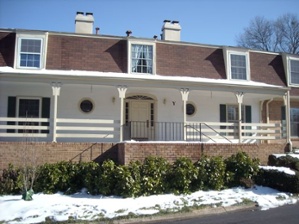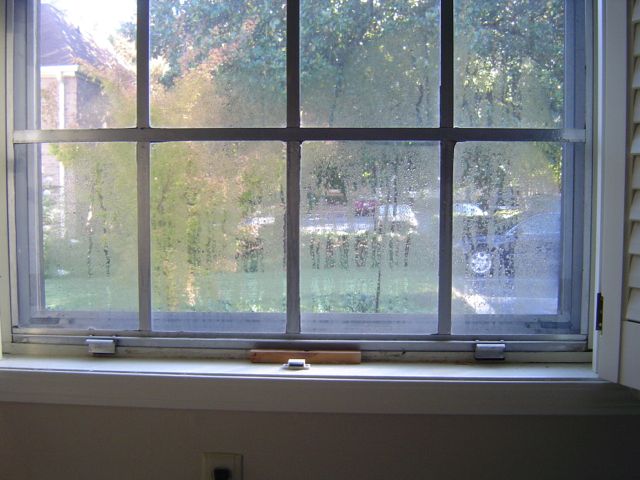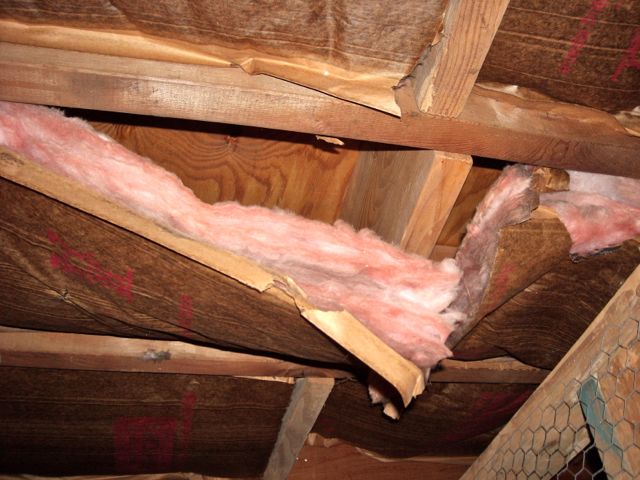Confessions of a Building Science Zealot

 Hi. My name is Allison, and I’m a building science zealot. I preach the gospel of building science, yet in my own life, I fall short of the perfection I exhort others to attain. Yes, I once built a green home that had many of the features I promote here, but if you’ve been reading this blog for a while, you know that my current residence is far from perfect. How so? Let me count the ways.
Hi. My name is Allison, and I’m a building science zealot. I preach the gospel of building science, yet in my own life, I fall short of the perfection I exhort others to attain. Yes, I once built a green home that had many of the features I promote here, but if you’ve been reading this blog for a while, you know that my current residence is far from perfect. How so? Let me count the ways.
Hi. My name is Allison, and I’m a building science zealot. I preach the gospel of building science, yet in my own life, I fall short of the perfection I exhort others to attain. Yes, I once built a green home that had many of the features I promote here, but if you’ve been reading this blog for a while, you know that my current residence is far from perfect. How so? Let me count the ways.
First, though, you should know that I live in a condo community that was built in 1970. Yeah, when I got divorced in 2006, she got the house, and I had to move out of the nice green home I built. I certainly didn’t begrudge her that, and after all, I did get to keep the original CFLs that we bought in 1992. (They still work, and I still use them.) I’ve written quite a few articles here that describe the problems with this condo, but here for the first time, I’ll try to put it all together for you.
The photo above is our building. It has four units, two on the first floor and two with pretty much the same footprint on the second floor. We’re on the first floor, right over the unconditioned, moldy basement.
The building enclosure sieve
Air leakage. I’ve done at least 10 blower door tests on my condo, many of them with HERS rater classes that I brought here. We’re currently at about 20 ACH50. You think that’s bad? Hey, it’s down from 32 ACH50, which we had for a while when two-thirds of the laundry room ceiling was missing! The main sources of air leakage are connections to the :
- Stairwell
- Fireplace chase
- Unconditioned basement
At least we don’t have one of the second floor units that came with a mechanical closet open to the attic…and with louvered doors to the inside!
Window dehumidifiers. As you might expect of a building built in 1970, it came with single-pane, metal frame windows, also known as window dehumidifiers. Even with the storm windows that a previous owner had installed, they have a tendency to act as condensing surfaces when it’s cold outside and humid enough inside. This typically happens in fall.

Floor insulation that does little to nothing. As I wrote three years ago when I discussed our crappy basement, the floor is insulated with fiberglass batts. The kraft paper facing is stapled to the floor joists near the bottom of the joists so they don’t touch the subfloor. And they’re only R-7. Why even bother doing the labor for something that’s not going to help? Oh, yeah, and many of them have already fallen out, as usual.

Miserable mechanical systems
As if all that isn’t bad enough, our condo has an 80 AFUE furnace and a natural draft water heater. Our ducts are nominally inside conditioned space since they run in a dropped ceiling between us and our upstairs neighbor’s unit. I wrote about the problems with atmospheric combustion a while back. I didn’t say it in that article, but the photos shown there are all from our condo.
Atmospheric combustion inside the building enclosure. If it’s not sealed combustion, it’s best to keep it outside the building enclosure. Of course, it’s really best to have all your heating and cooling equipment inside the building enclosure, which means ditch the atmospheric combustion stuff.

Common-vented furnace and water heater. Doing this can override a safety feature built into the furnace (more here). The natural draft water heater could be a risk for backdrafting and putting exhaust gases and carbon monoxide in our air. This is where our high air leakage actually helps, though. Because the condo is so leaky, there’s no problem with the draft.
Leaky ducts. The ducts are nominally inside conditioned space. That doesn’t mean they can’t leak to places outside our condo…and boy do they! For the pressure testing geeks out there, we’ve gotten fairly consistent duct leakage test results of >30 cfm25 per 100 square feet of conditioned floor area. That’s the amount of leakage to outdoors. Total leakage is even higher. For reference, ENERGY STAR Version 3 requires a maximum duct leakage of 4 cfm25 per 100 square feet.
Why haven’t I fixed all this yet?
Reason number 1: We have absolutely no financial incentive to do anything about it. Our gas isn’t metered individually, so the condo association pays that for us. Our monthly assessment covers that cost, and it won’t change if we replace our furnace. Our electric bill is low, too, especially after I replaced our 25 year air conditioner with a new one in 2009. We’ve averaged $58 per month on our May through September electric bills this year.
Reason number 2: We haven’t had any serious combustion safety issues, even with the potential problems I described above. Yeah, I worry about it and would love to change out that equipment, but…
Reason number 3: I came out of my 2006 divorce with a substantial amount of debt, mostly from building too much house and then investing in a new business that I shut down after two years. I finally got the debt paid off last year. Now I’m hoping to save some money to build something new rather than invest much in this place. (Maybe some day I’ll even be able to afford to do a Deep Energy Retrofit of the new house I build, kinda like Dr. Joe did a double-DER of his barn. Or not.)
Reason number 4: I’ve been too busy blogging about this stuff to do anything about it.
So, I’ll live with these building science problems and the inconsistency between my words and my life for a while longer. But I can see the light at the end of the moldy basement now. Or is that just the glowing eyes of a possum?
Related Articles
The Top 10 Mistakes I Made in Building a Green Home
3 Problems with Atmospheric Combustion Inside the Building Envelope
Looking at the Building Science Issues in an Old, Humid Basement
This Post Has 15 Comments
Comments are closed.

Allison,
Allison,
I think it’s good for us preachers and practitioners to live with imperfect homes.
1: It lets us empathize with our customers.
2: It keeps us humble.
3: It lets us maintain a minimum (miniscule?)cash balance.
Of course there is the “laboratory” argument too. I keep telling my wife that if I completely finish our house I won’t have any place to experiment 😉 While seldom successful it sometimes buys enough time to scrape together more cash from the miniscule balance column.
Thanks for sharing, a lot of us share your pain.
Bravo! None of us are perfect
Bravo! None of us are perfect, and it is important that people know that. I have issues with my house, I wrote about my icicles last winter. I’ve been considering a post about my own hypocracy so it’s all out there, well done for getting this out there!
Particular kudos for talking about the personal side of things, that is tough to admit, but gives a real life example and frankly makes me value your opinion more.
One last thing, it’s a shame about the financial incentive thing. Landlords whose tenants pay the utilities have the same issue, and it’s a real problem because those poor tenants (literally and figuratively) struggle to make a gas bill in cold Cleveland winters, making it hard to pay the rent. It would be good if we could adjust the incentives to help that, but that’s way beyond this post, or our capabilities, for a while.
Thanks for being honest.
Thanks for being honest.
FWIW, I own and manage a half
FWIW, I own and manage a half dozen rental units. We install at least mid-range heat pumps (2 stage SEER 16), CFL light bulbs, Energy Star fridges, etc. Any water heaters needed going forward will be HPWH.
I pitch the energy efficiency when advertising a property and make a “soft” warranty as to monthly energy costs: “If it exceeds $X, we’ll investigate and figure out why”.
Our abode neglect is typical
Our abode neglect is typical for all trades. The plumber has the worst plumbing on the block. The cabinet maker has not updated his cabinets. And an architect is content to live in a historic home with minimal changes.
Allison, have you thought of
Allison, have you thought of building on elf those pre-fab passive homes from a company in N. Carolina which they put together on a pad on your lot. I will get the name for you if you like, but I suspect you kno who they are…..
Been There… Done That.&
Been There… Done That.
Your new place will be better than the one you lost.
We’re all looking forward to looking over your shoulder when/as you build it.
Just think…. You can make back some $$ by selling the rest of us the building plans so we can build one like it.
Ira
Your condo sounds like a lot
Your condo sounds like a lot of apartment buildings I’ve worked on over the years. Sadly, even newer ones aren’t built all that much differently than your 1970 vintage model condo (many of which were orignally apartments and later converted to condos).
While I have yet to acquire all the nice building science forensic diagnostic tools (blower door, etc.), just a visual combing over of these type of units can reveal many compromises in the thermal and air boundaries of the structure. The last time I lived in an apartment, it had an air handler in a fur-down ceiling over the bathroom, and used a wall cavity for return air, plus the cavity created by the fur-down. Should be okay, ’cause it’s all in conditioned space, right?? Wrong. Every time my neighbor cooked or smoked, the odors were drawn into the return cavity for my a/c. Since I don’t smoke or cook greasy food, I didn’t appreciate my apartment smelling like I did.
Your Reason #4 gave me a good chuckle, but I find all of them valid. From an energy cost perspective there isn’t much incentive, but just out of curiosity I gotta wonder how comfortable that place is to live in, year round? I have to admit for my own house, improving our daily comfort has motivated me more to improve its performance than saving on energy and associated cost. Plus the huge amount of great learning that has taken place during my efforts.
Hope you can someday build your green home, with all of the wisdom you’ve acquired to date. Either that or find an architecturally cool existing house that really excites you, but is an energy and comfort mess…such as mine was when we bought it six years ago.
Ok, Allison, so are qualified
Ok, Allison, so are qualified to give marital advice? If not, you must have studied projectile motion — so there’s some overlap there, if nowhere else.
This energy stuff can really cause problems in relationships — like I let it get really hot in the summer before I turn on the AC and cold in the winter before I turn on the heat. I don’t like living in artificial conditions any more than I have to. Lots of women don’t dig that. My ex had to have the AC on when it got 75 or more outside. Drove me nuts! And I thought it was kind of crazy to think you should be wearing shorts and a tank top in the house in the winter. Lots of conflict over the thermostat setting.
I got into the energy thing after marriage. Big mistake. Here’s my advice — start researching energy/environment/economy issues before you get married, NOT after!!!
Maybe you got some better ideas.
Thanks.
Allison,
Allison,
How unfortunate you managed to locate the only woefully inadequate housing on this side of the galaxy :-(.
At least, it’s comforting to know so many folks living in such conditions, present company excepted, do so blissfully unaware of either the unseen conditions or the potential for much more comfortable and economical circumstances.
Best wishes
Nice article expressing the
Nice article expressing the problem of split incentive.
Hopefully On-Bill Recovery financing programs can help correct these issues. We need these easy opportunities to have incentive to address them.
I share the same woes, and
I share the same woes, and have been a bit embarrassed about it. Architect/high performance house blogger and cabinet maker living in a house we revamped before I knew anything about building science. We do have nice cabinets, but now that I know about building science, it’s pitifully embarrassing. Leaky old house, (I would bet that we’ve got your leaks beat by a lot) though we haven’t had it tested. Only saving grace is the bedroom we put off adding when we bought the house because we didn’t have the money is now going to be a passive house bedroom/studio. It will be separate from the main residence because that would be too much of a headache. I’ve been thinking about a post that lays it all bare as well, so thanks for beating me to it. Great inspiration! Thanks.
I love your comment about
I love your comment about “window dehumidifiers”. Wonderful article, Sir.
Joy of joys, my apartment
Joy of joys, my apartment complex finally TODAY (10/1/13) had a contractor come in and replace my dryer exhaust vent that was a shared 4″ pipe with an adjacent apartment with two separate 4″ vent pipes. It still has to go into the wall behind the dryer, up about 4 feet to the ceiling, and out about 18 to the exterior, through a total of 4 90 degree bends. But it no longer has an alternative path to someone else’s dryer.
The financial incentive for
The financial incentive for landlords thing is a conundrum. I do major renovations on 100yo 2-family houses and rent them out. They are almost all completely uninsulated in addition to having original galvanized water supply pipes and 4 electrical circuits (using fuses) that supply the whole 1200sf apartment when I buy them. I have never (ever) had anyone ask me if it is insulated. Each time I insulate an attic with blown cellulose and air seal the attic and basement I am making a donation to the charity called my tenants, because I am not getting any more rent for it. But I do it, every time – it just seems unethical not to.
I don’t however, spend the money for new direct vent boilers and water heaters, even when I replace them. The price difference is just too much, plus the added complexity for repairs is a negative.
It is just a shame, but Allison’s story points out how the market works – even for the guy who writes this blog, efficient energy uses wasn’t a major priority when selecting an apartment (condo).